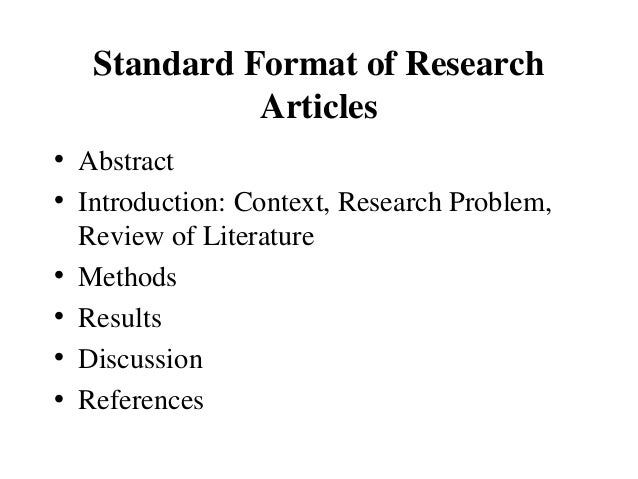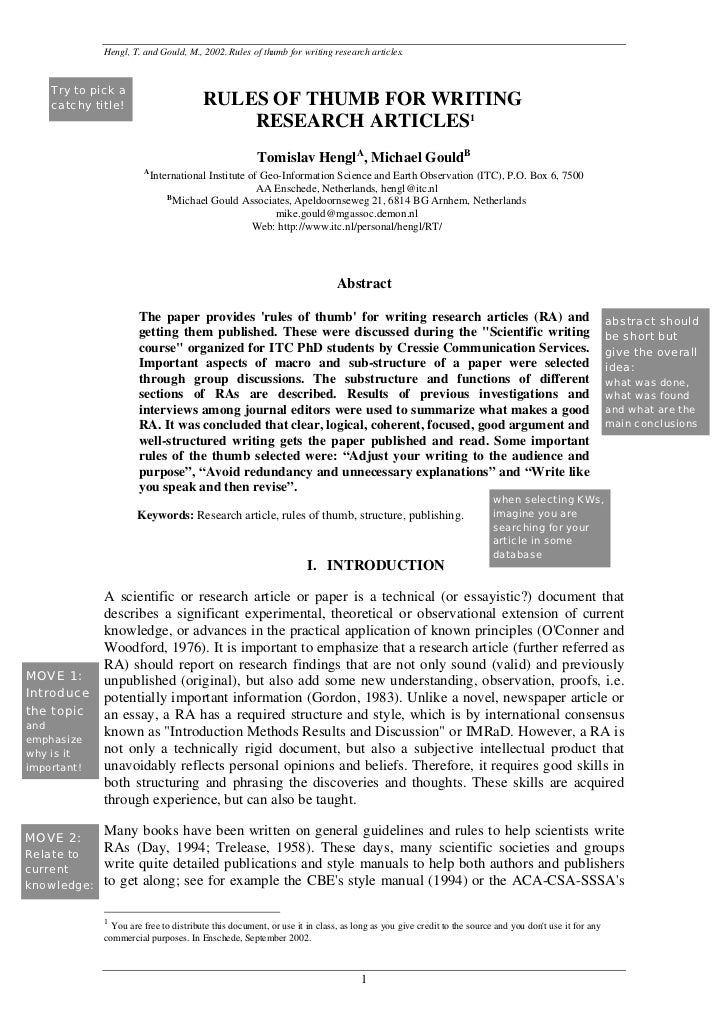
Why write an article? An article is potentially the most efficient means for disseminating your research and establishing a publication record; many areas of academic life such as finding employment and winning research grants depend on a good publication record Most research papers conclude with a restated thesis statement. Present your thesis again, but reword it. Briefly summarize the points you’ve made. Take a moment to explain why you believe those points support your case. If your research is inconclusive, take a moment to point out why you believe this topic bears further research A reasonable approach to writing a scientific manuscript may be the following. First write the Methods section, largely derived from your initial research protocol, and perhaps during the experimental phase of the work itself so that all details are included. Construct all of the figures and tables that contain theFile Size: 1MB
Twenty Steps to Writing a Research Article | Graduate Connections | Nebraska
Thomas V. Perneger, Patricia M. Writing research article writing papers does not come naturally to most of us. The typical research paper research article writing a highly codified rhetorical form [ 12 ]. Knowledge of the rules—some explicit, others implied—goes a long way toward writing a paper that will get accepted in a peer-reviewed journal.
A good research paper addresses a research article writing research question. The research question—or study objective or main research hypothesis—is the central organizing principle of the paper. This is perhaps obvious when the paper research article writing on a well planned research project.
However, in applied domains such as quality improvement, some papers are written based on projects that were undertaken for operational reasons, and not with the primary aim of producing new knowledge. In such cases, authors should define the main research question a posteriori and design the paper around it. Generally, only one main research question should be addressed in a paper secondary but related questions are allowed. If a project allows you to explore several distinct research questions, research article writing, write several papers.
For instance, if you measured the impact of obtaining written consent on patient satisfaction at a specialized clinic using a newly developed questionnaire, you may want to write one paper on the questionnaire development and validation, and another on the impact of the intervention, research article writing.
What is a good research question? The key attributes are: i specificity; ii originality or novelty; and iii general relevance to a broad scientific community.
The research question should be precise and not merely identify a general area of inquiry. A study does not necessarily have to break completely new ground, but it should extend previous knowledge in a useful way, or alternatively refute existing knowledge.
Finally, the question should be of interest to others who work in the same scientific area. The latter requirement is more challenging for those who work in applied science than for basic scientists. While it may safely be assumed that the human genome is the same worldwide, whether the results of a local quality improvement project have wider relevance research article writing careful consideration and argument.
Once the research question is clearly defined, writing the paper becomes considerably easier. The paper will ask the question, then answer it. The key to successful scientific writing is getting the structure of the paper right.
The basic structure of a typical research paper is the sequence of Introduction, Methods, Results, and Discussion sometimes abbreviated as IMRAD. Each section addresses a different objective. The authors state: i the problem they intend to address—in other terms, the research question—in the Introduction; ii what they did to answer the question in the Methods section; iii what they observed in the Results section; and iv what they think the results mean in the Discussion.
In turn, each basic section addresses several topics, and may be divided into subsections Table 1. In the Introduction, the authors should explain the rationale and background to the study. What is the research question, and why is it important to ask it? While it is neither necessary research article writing desirable to provide a full-blown review of the literature as a prelude to the study, it is helpful to situate the study within some larger field of enquiry.
The research question should always be spelled out, and not merely left for the reader to guess. The Methods section should provide the readers with sufficient detail about the study methods to be able to reproduce the study if so desired. Thus, this section should be specific, concrete, technical, and fairly detailed. The study setting, the sampling strategy used, instruments, data collection methods, research article writing, and analysis strategies should be described.
In the case of qualitative research studies, it is also useful to tell the reader which research tradition the study utilizes and to link the choice of methodological strategies with the research goals [ 3 ]. The Results section is typically fairly straightforward and factual. All results that relate to the research question should research article writing given in detail, including simple counts and percentages.
Resist the temptation to demonstrate analytic ability and the richness of the dataset by providing numerous tables of non-essential results.
The Discussion section allows the most freedom. This is why the Discussion is the most difficult to write, and is often the weakest part of a paper. Structured Discussion sections have been proposed by some journal editors [ 4 ]. While strict adherence to such rules may not be necessary, following a plan such as that proposed in Table 1 may help the novice writer stay on track, research article writing.
References should be used wisely. Key assertions should be referenced, as well as the methods and instruments used. However, unless the paper is a comprehensive review of a topic, there is no need to be exhaustive. Also, references to unpublished work, to documents in the grey literature technical reportsresearch article writing, or to any source that the reader will have difficulty finding or understanding should be avoided.
Having the structure of the paper in place is a good start. However, there are many details that have to be attended to while writing. Another concerns non-native writers of English: do have a native speaker edit the manuscript. A paper usually goes through several drafts before it is submitted. When revising a paper, it is useful to keep an eye out for the most common mistakes Table 2. If you avoid all those, your paper should be in good shape. Huth EJ. How to Write and Publish Papers in the Medical Sciencesresearch article writing, 2nd edition.
Browner WS, research article writing. Publishing and Presenting Clinical Research. Devers KJFrankel RM. Getting qualitative research published. Educ Health ; 14 : — Docherty MSmith R. The case for structuring the discussion of scientific papers. Br Med J ; : — Oxford University Press is a department of the University of Oxford. It furthers the University's objective of excellence in research, scholarship, and education by publishing worldwide.
Sign In or Create an Account. Navbar Search Filter This issue All International Journal for Quality in Health Care All Journals Mobile Microsite Search Term Search. Sign In. Issues More Content Advance articles Editor's Choice Submit Author Guidelines Submission Site Open Access Purchase Alerts About About International Journal for Quality in Health Care About the International Society for Quality in Health Care Editorial Board Advertising and Corporate Services Journals Career Network Self-Archiving Policy Dispatch Dates Contact ISQua.
Issues More Content Advance articles Editor's Choice Submit Author Guidelines Submission Site Open Access Purchase Alerts About About International Journal for Quality in Health Care About the International Society for Quality in Health Care Editorial Board Advertising and Corporate Services Journals Career Network Self-Archiving Policy Dispatch Dates Contact ISQua Close search filter This issue All International Journal for Quality in Health Care All Journals search input Search.
Advanced Search. Search Menu. Skip Nav Destination Article Navigation. Close mobile search navigation Article Navigation.
Volume Article Contents Primacy of the research question. Structure of the paper. The basics. Article Navigation.
Writing a research article: advice to beginners Thomas V. PernegerThomas V. Quality of Care Unit, Geneva University Hospitals, research article writing, Geneva, Switzerland, research article writing.
Oxford Academic, research article writing. Google Scholar. Patricia M. Department of Community Medicine, Geneva University Hospitals, Geneva, Switzerland. PDF Split View Views. Cite Cite Thomas V. Select Format Select format. ris Mendeley, Papers, Zotero. enw EndNote. bibtex BibTex. txt Medlars, RefWorks Download citation. Permissions Icon Permissions. Close search filter This issue All International Journal for Quality in Health Care All Journals search input Search.
Primacy of the research question A good research paper addresses a specific research question. Structure of the paper Once the research question is clearly defined, writing the paper becomes considerably easier. Table 1 Typical structure of a research paper. Describe participants demographic, research article writing, clinical condition, etc. Open in new tab.
How to write a scientific paper
, time: 8:34Writing an article - Research & Learning Online

Most research papers conclude with a restated thesis statement. Present your thesis again, but reword it. Briefly summarize the points you’ve made. Take a moment to explain why you believe those points support your case. If your research is inconclusive, take a moment to point out why you believe this topic bears further research 6/1/ · Writing research papers does not come naturally to most of us. The typical research paper is a highly codified rhetorical form [1, 2]. Knowledge of the rules—some explicit, others implied—goes a long way toward writing a paper that will get accepted in Cited by: 23 Start by writing a summary that includes whatever you think is important, and then gradually prune it down to size by removing unnecessary words, while still retaini ng the necessary concepts. 3. Don't use abbreviations or citations in the abstract

No comments:
Post a Comment